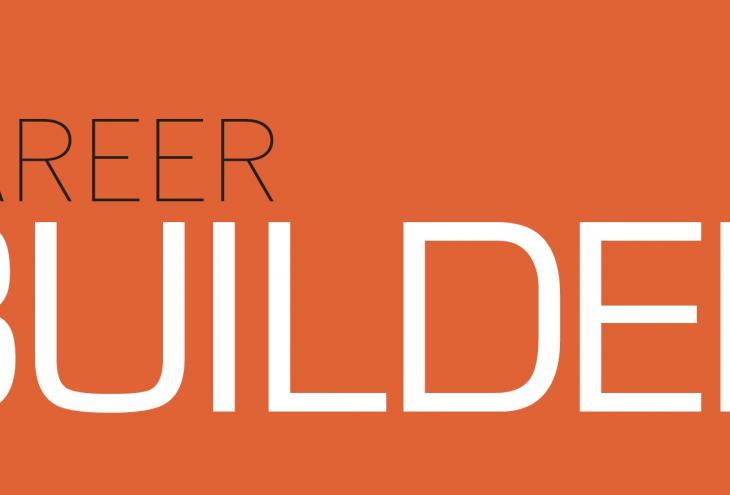Native Explorers
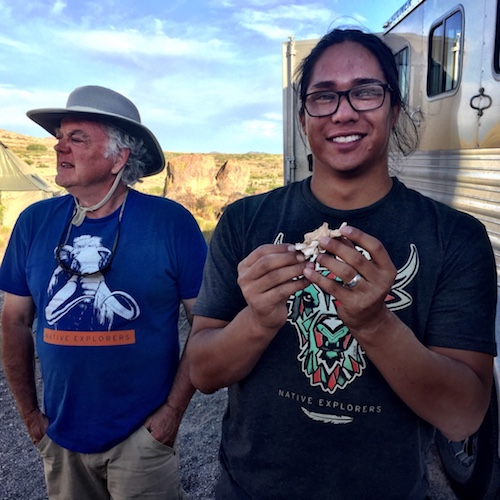
knowledge of science, medicine, and
Native cultures.
Indigenous students who are curious about medicine and vertebrate fossils (saber-toothed cats, rhinos, horses, and bone-crushing dogs) will be right at home in the Native Explorers program. The hands-on program is offered each year through the Oklahoma State University Center for Health Sciences in Tulsa, Okla. (There’s also a Junior Explorers option for pre-K through 12th-grade students, offered through the Chickasaw Nation.)
The nonprofit Native Explorers Foundation’s mission is to increase the number of Native Americans pursuing careers in STEM and medicine. The flagship program for the foundation is Native Explorers, which focuses on the disciplines of anatomy and vertebrate paleontology to provide off-campus activities for students as they work side by side with Native American scientists, physicians, and graduate students. Themes covered during the 12-day field-based curriculum include climate change, evolution, comparative osteology, stratigraphy, mapping, healthy lifestyles, and Native culture.
The annual application deadline is March 1, and the program generally takes place in May. Eligible applicants must meet these qualifications: be at least 18 years old; be an enrolled member of a federally recognized tribe; have earned a high school diploma or equivalent; have a good academic background (grades and service); have a letter of recommendation from an instructor or advisor; and be interested in learning about science and medicine.
The Native Explorers program is free to all participants thanks to generous support from the Chickasaw Nation, the Cherokee Nation, the Choctaw Nation of Oklahoma, the Whitten Burrage Law Firm, the Native Explorers Foundation, and the OSU Center for Health Sciences. Successful participants are eligible to earn three hours of college credit from Oklahoma State University.
Ask the Founder
Native Explorers is the brainchild of Dr. Kent Smith, who founded the program 10 years ago as a way to recruit and educate the next generation of Native Americans in science and medicine. Dr. Smith, Comanche and Chickasaw, is a professor of anatomy at OSU’s Center for Health Sciences. He also serves as associate dean of the Office of American Indians in Medicine and Science and is a research associate at the Sam Noble Oklahoma Museum of Natural History.
What inspired you to start Native Explorers? My Native heritage is a great privilege and source of pride. A decade ago, I was seeing very few medical students who were Native American, and I wanted to change that. In my opinion, one of the greatest barriers to more Native students pursuing STEM and medicine is a paucity of Native mentors. If our Native youth and young adults don’t see people who look like them in these careers, they’re less likely to see themselves on a professional path in STEM or medicine.
Can you explain the link between paleontology and medicine? We’ve definitely seen this happen. It’s a very unique opportunity, and participants describe it as a defining experience in their lives. From a more practical perspective, as we excavate fossil bones, skulls, and teeth of ancient mammals, we translate what we see and learn to human osteology and medicine. For example, to the untrained eye the bones of the human hand look similar to those of a black bear. Using the comparative method, the students learn how to differentiate the bones of humans from those of other mammals. Analogous to a physician using the method of differential diagnosis on a patient, we examine the morphology of the fossil remains and look for possible pathologies caused by injuries or diseases to build a story about the life history of the ancient animal.
What exactly happens over the course of the program? It starts at the Center for Health Sciences campus in Tulsa, where we spend the first day conducting an orientation, including an overview of topics such as comparative anatomy, diseased and healthy organs, and how to prospect, collect, preserve, and identify fossil remains. We also have Native physicians and medical students on hand to lead discussions about medicine, lifestyle, and health. After we establish this foundation, we set off for an 11-day dig at one or two active research fossil quarries managed by me or my colleague Dr. Nicholas Czaplewski, who is a curator at the Sam Noble Oklahoma Museum of Natural History.
What if someone is interested in the program but they’ve never been camping? All qualified students with a genuine interest are encouraged to apply. We’ve had successful participants from diverse backgrounds across the country, and many have never set up a tent or camped before. To be sure that everyone is safe and prepared, on the first day we offer instruction on terrain and wildlife and skills such as reading topographical maps and using hand gear like a compass or GPS unit. I’ve seen students with very little outdoor experience perform very well.
What else is unique about the program? To my surprise, for many explorers the program has been their first real exposure to their own Native heritage and culture. A strong component of the program is not only STEM, but traditional ways and culture. All participants have the assignment of bringing something from their heritage — like a story, a song, a dance — which requires them to look into where they’re from, who their people are. Then we have different tribes represented around the camp at night, sharing their stories. In recent years, we have engaged more with the Chickasaw and Cherokee Nation culturalists to learn about their beliefs and history, participate in cultural activities, and spend a night in their traditional villages.
How have you seen the program impact students’ educational and career paths? We’ve had nearly 120 participants complete our program so far. Most of them go on to earn their undergraduate degrees and many have gone on to graduate programs in STEM fields or professional programs in health care (e.g., medicine, physician assistant, nursing, and physical therapy) and law. In fact, past participants in the Native Explorers program compose about 5 percent of the first-year class of OSU’s College of Osteopathic Medicine. (Native American students make up about 16 percent of the class.) Nationally, about 0.2 percent of the students enrolled in medical schools (osteopathic and allopathic) are Native American. We’ve also seen a number of participants go back to their tribes and work within their tribal systems — decisions they all say were influenced by their Native Explorers experience.
Environmental Stewardship of Indigenous Lands
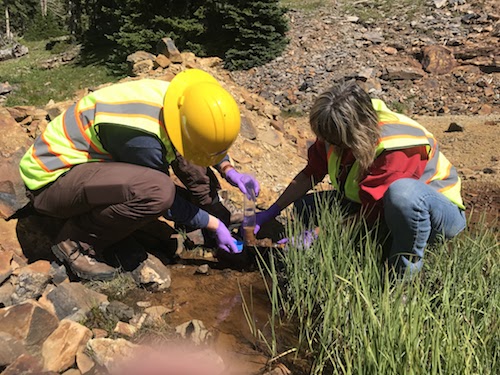
training, internships, and job
placement opportunities.
Safeguarding natural resources is a major focus of a new certificate program for students interested in environmental issues. The Environmental Stewardship of Indigenous Lands (ESIL) certificate program at the University of Colorado Denver (CU Denver) is a first-of-its-kind opportunity that provides training, internships, and job placement support for qualifying college students.
CU Denver launched the ESIL program after deliberating with like-minded organizations interested in preventing environmental incidents and degradation on Indigenous lands across the country. The integrated curriculum addresses the laws, regulations, cultural considerations, natural resources priorities, and financial interests that must be navigated in environmental stewardship. Its coursework helps students prepare for careers as liaisons between tribal and non-tribal stakeholders as they negotiate about the use and protection of Native American, Alaska Native, and Native Hawaiian resources.
Based in downtown Denver, this one-year program was developed with STEM majors in mind and opens the possibility to work locally and nationally with tribes and government organizations. Students pursuing STEM degrees (especially in biology, civil engineering, and geology and environmental sciences) can earn the ESIL certificate concurrent with their undergraduate coursework.
Ask a Program Founder
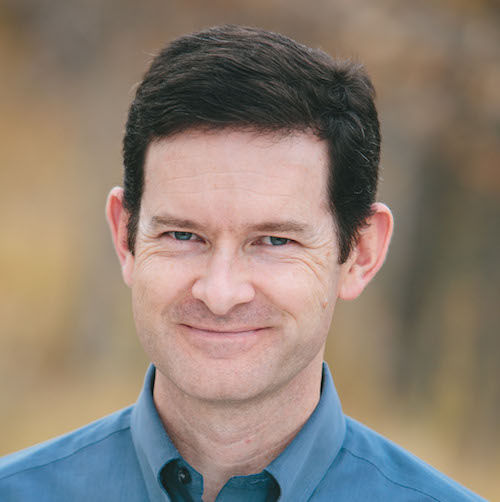
An associate professor of civil engineering at CU Denver, Dr. David Mays played a central role in designing and delivering the school’s ESIL certificate program and serves as ESIL’s civil engineering advisor.
How did this program get started? One of my colleagues from our Department of Integrative Biology, Dr. Timberley Roane, is from the Lumbee Tribe of North Carolina. She has been collaborating for years with Native scientists outside the university as well as with our Native students. It became clear after a number of conversations that there’s a need for students in science and engineering who have cultural awareness and mediation skills to become effective environmental liaisons between tribal and non-tribal stakeholders.
What are the academic underpinnings of the program? We want our ESIL candidates to have breadth and depth in STEM, so everybody gets exposure to the basic sciences — classes in biology, chemistry, physics, calculus, and geology. The next level of study includes environmental engineering, geographic information systems, and statistics — so that people can begin to advance beyond facts and numbers to more critical thinking. As part of their core curriculum, we also ask students to take courses in either communications and diversity or leveraging diversity for inclusion in business. In addition, they take a class in either environment, society and sustainability, or public health.
What else is involved in the program? Beyond the coursework, there are two key components: extracurricular activities and internships. The extracurricular activities involve culturally relevant training in topics such as tribal self-determination and environmental law. Students participate in these extracurricular activities alongside active tribal liaisons who share their experiences and help students with the professional skills development needed for success. In addition, students are required to complete at least one internship where they practice aspects of facilitation as a tribal liaison for a tribal, state, or U.S. federal agency. For example, this summer we are planning internships with the Southern Ute Indian Tribe in Colorado and the Northern Arapaho Tribe on the Wind River Reservation in Wyoming.
What is your overall objective in this inaugural year of the program? This program is all about giving students a deep grounding in science as well as in critical, complementary non-technical skills. We want to provide a better path forward for stewarding land and natural resources in a way that’s respectful from multiple perspectives. The need comes down to finding ways to communicate on and elucidate challenging environmental issues. Meeting that need requires facilitating conversations between people who may not see eye to eye but ultimately can work together and find resolution. We’re equipping people to help make that happen with an education that goes well beyond a STEM curriculum and is driven by a compelling purpose.
Emma Bowen Foundation Fellowship Program
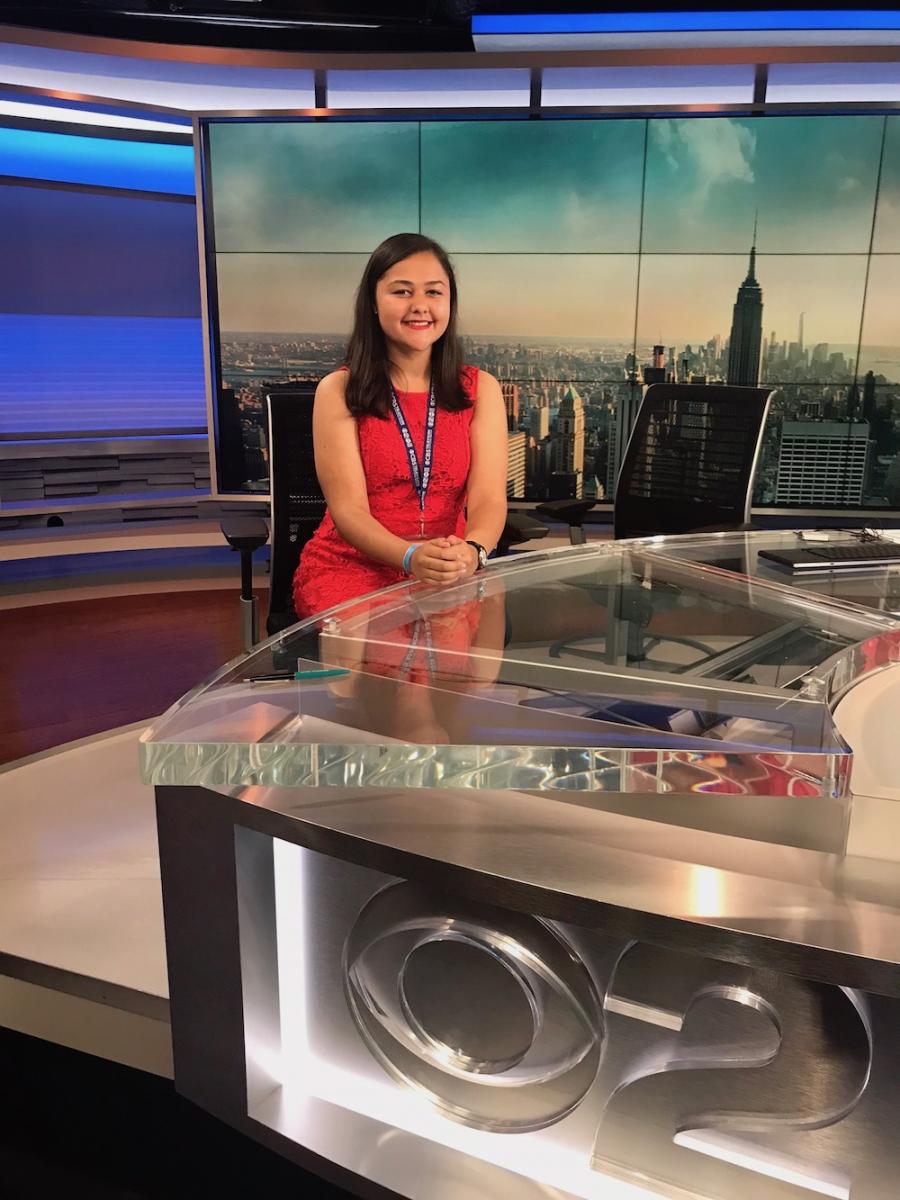
Ammons at CBS in
New York City
The Emma Bowen Foundation Fellowship Program offers multiyear paid internships for college students of color pursuing careers in media and technology. Emma Bowen partners with more than 50 employers across the United States every summer to offer internships in fields ranging from television news and media relations to engineering, data analytics, social media, and finance.
“Emma Bowen is about truly creating a career path,” says Senior Vice President for National Recruitment Sandra Rice. “We’re all about putting interns in a strong position to build their resumes and succeed wherever they choose.” Now in its 30th year, Emma Bowen is unique in that students can benefit from up to four summers of internship work, beginning as early as the summer after high school. Returning to the same partner employer every year gives interns a chance to establish professional relationships and refine their skills as they advance in their education.
Eligible applicants for an Emma Bowen Fellowship must be a U.S. citizen or permanent resident and meet the following qualifications: be a student of color (African American, Asian American, Latino, or Indigenous); be a graduating high school senior or a current college student; have a cumulative grade point average of at least 3.0; be interested in pursuing a career in media or technology; attend or plan to attend a four-year accredited college or university; and speak and write English fluently.
Students selected for the program are paid for their internship work and also have the opportunity to qualify for additional funding to help pay college expenses. Fellows who complete the program become part of an exclusive alumni database used by partner company recruiters. Approximately 80 percent of Emma Bowen fellows are hired for post-collegiate jobs in media and technology.
Ask a Participant and a Principal
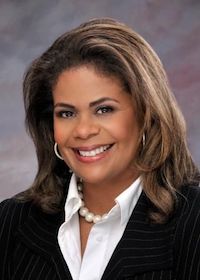
Emma Bowen fellow Meredith Ammons is a sophomore at the University of North Carolina at Chapel Hill majoring in media and journalism. In 2018 she completed her first summer as an intern at CBS2 in New York. Ammons plans to build on her success in upcoming summers as she continues to work for CBS2 and pursue a career in journalism. Sandra Rice is Emma Bowen’s senior vice president for national recruitment.
Where do the internships take place and what fields do Emma Bowen interns and alumni pursue? Rice: We place interns literally all over the country. Our company is housed by NBCUniversal in New York and CBS in Los Angeles, but we also have partners from coast to coast, north and south. We have a strong track record of placements in newsrooms and far beyond. In addition to jobs as reporters, producers, and directors, we have alumni working in fields such as engineering, data analytics, cybersecurity, design, public relations, and finance.
What are some of the highlights of the experience? Ammons: I have so many highlights from my time in
New York! One time, I went to the federal court ICE hearings for the pizza delivery man deportation case. Another time, I had the opportunity to interview the mayor of Freeport, N.Y., about a fire.
Rice: A highlight is our annual summer conference where nearly 200 fellows convene in New York for four days. The event includes talks by industry leaders, networking conversations with alumni, and a career fair with top employers that like to hire from our talent base.
How can this experience help to shape an intern’s career path? Ammons: My internship experience not only cemented my path in the field of journalism but also helped me expand my horizons. Being an Emma Bowen fellow has truly changed my life. It has given me the opportunity to get a head start over my peers in my field of choice.
What do you think distinguishes Emma Bowen fellowships from other internship opportunities? Rice: We not only show people what’s possible; we help them break through the cement ceiling — and that’s what it is for people of color in media and technology. Our fellows build professional relationships they often keep for life. And we’re always there for them — we never let go.
Agri-Business Incubator Program
 Eastern Oklahoma State College is a leader in teaching aquaponics, a sustainable agriculture method of growing all-natural produce and fish using a recirculating water system. The school has partnered with award-winning company Symbiotic Aquaponic to install an extensive aquaponic system that serves both as a living laboratory and as the home of the Agri-Business Incubator Program.
Eastern Oklahoma State College is a leader in teaching aquaponics, a sustainable agriculture method of growing all-natural produce and fish using a recirculating water system. The school has partnered with award-winning company Symbiotic Aquaponic to install an extensive aquaponic system that serves both as a living laboratory and as the home of the Agri-Business Incubator Program.
Aquaponic farming is a rapidly growing market. Over the past seven years, Eastern and Symbiotic Aquaponic have built nearly 100 aquaponic systems across nine states with partners in Arkansas, California, Colorado, Nebraska, Oklahoma, Oregon, Pennsylvania, Texas, and Wisconsin. They frequently partner with Native American tribes to design and deliver STEM courses in local schools and establish agricultural systems and food distribution channels among tribal members.
Eastern’s Agri-Business Incubator Program offers training for people interested in a career focused on aquaponics. The first-of-its-kind certificate course in Oklahoma is open to the public and includes instruction on the processes and procedures required to earn certification as an organic producer from the Department of Agriculture (USDA). Participants complete a curriculum that integrates classroom coursework and discussion with hands-on greenhouse training. Both 90-day and one-day certificate courses are offered throughout the year.
Ask an Incubator Program and Aquaponics Pioneer
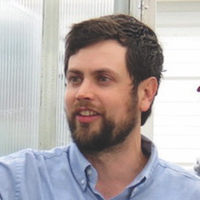
Symbiotic Aquaponic President and CEO Kaben Smallwood grew up helping on his grandparents’ farm in southeast Oklahoma. Along with his brother Shelby, Kaben founded Symbiotic Aquaponic seven years ago and oversees its farm operations. A trained economist, he is a proud member of the Choctaw Nation of Oklahoma.
Can you give us a snapshot of how aquaponic farming works? It’s about establishing very efficient growing systems. Aquaponic agriculture produces plants without the use of soil. Wastewater from the fish provides all the nutrients plants need, and in turn the plants help clean the water and make it a healthy environment for the fish. It’s a mutually beneficial ecosystem, which is where the name “symbiotic” comes from.
What are some of the advantages of aquaponic farming? Because it’s a closed, recirculating system, aquaponic farming is highly efficient and uses more than 90 percent less water than traditional farming. Also, when farmers are able to earn organic certification, it’s a great differentiator for them in the marketplace. A primary economic benefit is that farmers are able to improve the price of what they produce and get a much better financial return on their crops.
Tell us about the incubator program. Our incubator program has been running for about two years through the Continuing Education program at Eastern Oklahoma State College. The purpose is to train folks to either run their own aquaponic farm or assist in providing related services in the industry. It’s education driven so that someone with even zero experience with aquaponics can learn everything they would need to start an aquaponic business.
What kinds of opportunities have your graduates pursued? Changing market opportunities have prompted people to look more seriously at sustainable technologies. One thing that happened in Oklahoma recently that changed the equation was the legalization of industrial hemp and CBD [cannabidiol, a non-pyschoactive phytocannabinoid derived from cannabis]. Legalization has further improved the economic prospects for aquaponic systems. We have seen recent graduates become successful aquaponic commercial farmers — with areas of focus including USDA-certified organic CBD production and fresh produce sales to farmers markets and restaurants. It’s a very promising field, and we’re excited to see people learn to farm in a way that significantly helps them as professionals and helps their families and their communities.


